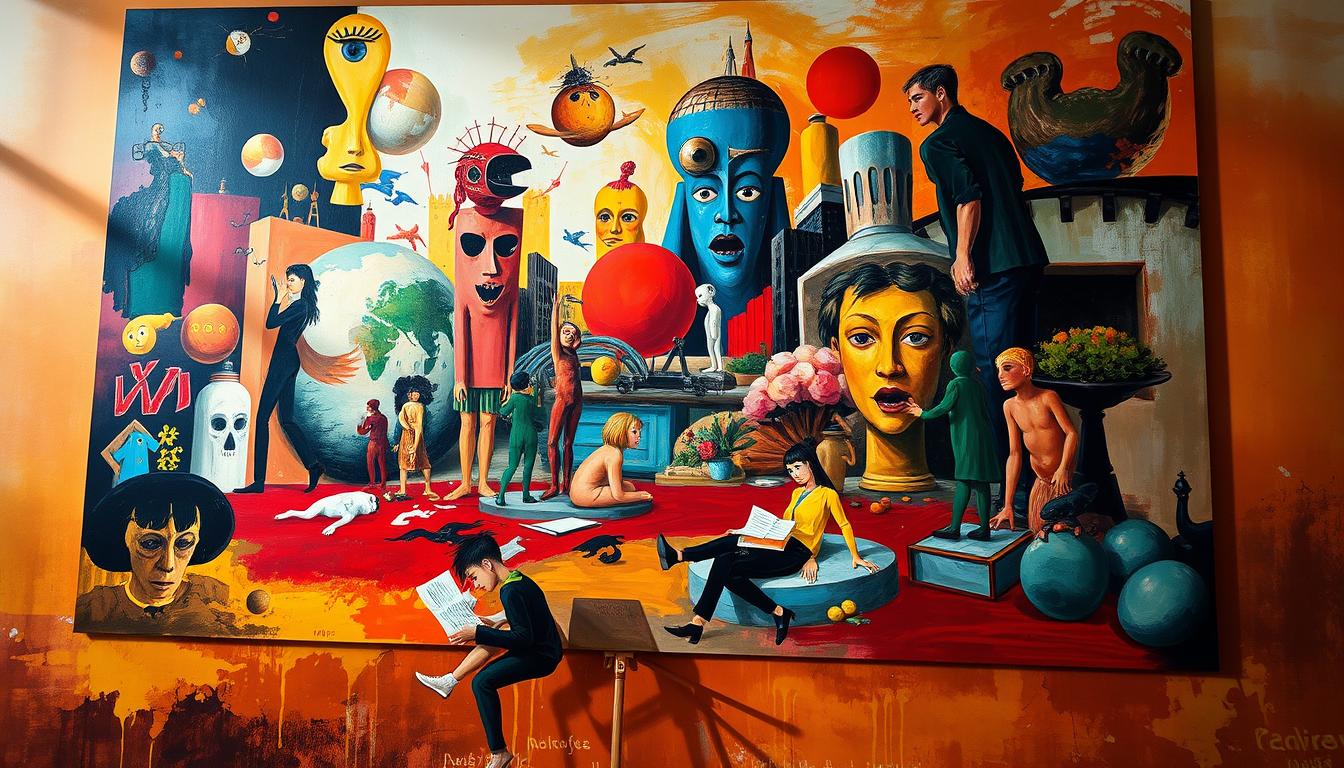Question: Are there modern Expressionism artists who still make painting feel urgent and alive, or has that energy faded into museum history?
Yes — voices in the art world keep that urgency going. Neo-Expressionism exploded in the late 1970s and reasserted emotion over cool minimalism. Jean-Michel Basquiat stands out for graffiti‑infused truth, and the 1981 Royal Academy show reignited interest in painting.

Today, figures like Robert Nava and Miriam Dema extend that raw charge with mixed media and bold brushwork. Dealers such as Mary Boone and Annina Nosei helped push the market, and collectors now seek work that feels immediate and honest.
This list highlights painters who balance 20th century roots with present‑day risk, offering style, story, and palpable emotion. Expect established names and rising voices whose paintings cut straight to feeling.
Key Takeaways
- Yes, contemporary expressionist voices remain active and influential.
- Neo‑Expressionism revived emotional painting against Minimalism.
- Basquiat and the 1981 Royal Academy show shaped the renewed interest.
- Today’s painters mix raw brushwork with text and mixed media.
- Collectors value immediacy, narrative depth, and emotional clarity.
What “modern Expressionism” means today: from 20th-century roots to contemporary art
The term links early 20th-century emotion to current visual life. Modern expressionism describes painting and mixed media that keep distortion, urgency, and personal truth at their core.
By the late 1970s, Neo-Expressionism reignited that force across Europe and the U.S. German Neue Wilde dug into history and trauma. Italy’s Transavanguardia returned myth and classical motifs. New York fused street culture with postmodern layering.
Critics and institutions helped legitimize the shift back to the artist’s hand. Shows like the Royal Academy’s 1981 exhibition and dealers such as Mary Boone and Annina Nosei made figurative work visible again.
Why it matters: this lineage supplies today’s painters with a language that blends memory, pop culture, and raw brushwork. The result is a flexible approach, not a single school—it adapts across media and generations.
- Key traits: wild brushwork, intense color, charged figures
- Legacy: personal memory meets public culture
- Continuity: the movement’s DNA keeps painting urgent and relevant
For a deeper historical overview, see the Modern Expressionism overview.
Modern Expressionism: artists you should know today
A new generation of painters keeps raw feeling at the center of their canvases.

Jean-Michel Basquiat
Basquiat fused graffiti, poetry and anatomy into charged canvases. His work reshaped how the world reads figures and text on a canvas.
Robert Nava
Nava animates mythic beasts with spray paint, acrylic and grease pencil. Museums like the Art Institute of Chicago own his work, which feels playful and raw.
Jordy Kerwick
Kerwick layers oil, enamel and charcoal to build hybrid creatures. The saturated scenes read like bold, immediate painting.
Miriam Dema & Charlotte Rose
Miriam Dema records tender, memory-built moments with oil pastels and sticks. Charlotte Rose interrogates branding using oil and acrylic, turning logos into cultural critique.
Other notable names
Fanny Brodar, Stella Kapezanou, Dave White, Enzo Marra, Nick Malone, Jane Pryor and José Manuel Merello extend the movement through diary-like surfaces, theatrical animals, monochrome impasto and text-rich color fields.
| Name | Notable Traits | Media | Key Venues |
|---|---|---|---|
| Basquiat | Graffiti, text, anatomy | Oil, mixed media | 1980s New York galleries |
| Robert Nava | Fantastical creatures, spontaneity | Acrylic, spray, grease pencil | Art Institute of Chicago, MAM Paris |
| Jordy Kerwick | Saturated hybrids, pattern | Oil, enamel, house paint | High collector demand (Artsy) |
| Miriam Dema | Memory, intimacy | Oil pastels, sticks | Maddox Gallery exhibitions |
How modern expressionists paint emotion: styles, techniques and forms
Painters today shape feeling through texture, color, and wildly confident marks. That mix of speed and care lets a surface read as mood before the subject arrives.
Brushstrokes, texture and impasto: from urgency to atmosphere
Brushstrokes carry narrative weight. Nava’s impulsive lines and layered marks spark a raw, immediate register on canvas.
Marra’s dense impasto shifts atmosphere as you move. Broad, urgent strokes can mean instinct; slow glazing creates quiet, reflective time.
Materials and methods: oil, acrylic, spray paint, pastels and mixed media
Technique equals tone. Kerwick pairs oil, enamel, charcoal, house paint and airbrush to fuse myth and domestic detail.
Dema’s oil sticks and pastels preserve memory and immediacy. Mixed media lets incompatible materials collide and make fresh edges.
Figuration returns: mythic beasts, everyday life and symbolic figures
Figuration gives work story and psychology. Mythic beasts and ordinary scenes let painters encode culture directly into the picture.
"Painting's plasticity — weight, sheen and layered skin — cannot be fully captured on screens."
Why that matters: gloss, gold leaf and dust in White’s surfaces heighten presence and drama. Merello’s point reminds collectors why seeing original work is vital.
| Element | Example Maker | Techniques | Emotional Effect |
|---|---|---|---|
| Spontaneous mark-making | Robert Nava | Spray, acrylic, grease pencil | Urgency, playfulness |
| Layered hybrid media | Jordy Kerwick | Oil, enamel, charcoal, airbrush | Mythic + domestic tension |
| Monochrome impasto | Enzo Marra | Thick paint, palette knife | Depth, shifting atmosphere |
| Surface theatrics | Dave White | Gold leaf, gloss, particulate dust | Presence, spectacle |
Forms and techniques work as a spectrum. From raw gesture to restrained passage, the movement proves that emotion in art can be forceful or subtle and still read clearly.
For context on the movement's roots and language, see this expressive history.
From late 20th century to the present: the movement’s evolution and market relevance
The late 20th century reset painting’s role in the global art market and seeded today’s energetic scene.
Neo‑Expressionism surged in the late 1970s and found a flashpoint with the 1981 Royal Academy show, A New Spirit in Painting. That exhibition helped reclaim the canvas as a primary site of feeling and narrative.
Dealers like Mary Boone and Annina Nosei amplified visibility, while Jean‑Michel Basquiat’s rapid ascent signaled a seismic shift in collector interest and market power.

Neo‑Expressionism’s resurgence across the United States and Europe
Galleries and institutions translated critical buzz into market momentum. Shows, biennials and museum acquisitions turned energetic painting into bankable work.
Why collectors respond: authenticity, narrative depth and emotional voltage
Collectors look for coherence over time, institutional placements and the felt weight of a piece. Today’s generation of painters — from Robert Nava to Jordy Kerwick — merge raw mark‑making with story. That blend speaks across the art world and helps sustain value.
"Raw, tactile painting carries a directness that many collectors prize."
- Market matured: advisors and curated platforms connect buyers to meaningful works.
- Painting stays central, flexible to new materials and global dialogue.
Are there modern Expressionism artists?
Yes. Contemporary painters still charge canvases with urgent, visceral energy that reads as direct feeling.
Names matter. Jean‑Michel Basquiat’s influence remains central, and living figures like Robert Nava, Jordy Kerwick, Miriam Dema, Charlotte Rose and Fanny Brodar carry the thread forward.
These expressionists use bold figuration, quick gestures and layered surfaces. They mix oil, spray, pastels and collage to build works that hit with theatrical and psychological force.
Why it matters: collectors and museums show these pieces at fairs and exhibitions across the United States. Institutional placements and gallery programs keep this painting visible and market‑relevant.
If you want work that feels immediate, tactile and truthful, this movement still delivers.
- Direct mark‑making creates emotional power on the surface.
- Figurative symbolism gives narrative and memory.
- Mixed media expands how art speaks to viewers today.
Where to see and collect contemporary expressionist artworks in the U.S. today
Collectors who want alive, tactile painting will find it in curated U.S. exhibitions and trusted galleries. Museums and fairs stage shows that echo the Royal Academy’s 1981 revival of painterly practice, giving viewers context and scale.
Galleries and exhibitions: Royal Academy lineage to contemporary showcases
Visit gallery programs like Maddox Gallery and museum exhibitions that highlight painters with strong narrative and material presence. Seeing works in person helps you judge surface, scale and life on the canvas.
Curated platforms and advisors: discovering rising expressionist artists
Art advisors and curated platforms translate market signals—exhibitions, institutional acquisitions, critical coverage—into buying advice that fits people’s taste and goals over time.
"Viewing original work is the best way to gauge presence and material conviction."
- Attend group shows to compare style and technique in one visit.
- Use advisors to find artworks across price points, from emerging to museum-recognized names.
- Track fair calendars and museum highlights like the McNay highlights for emerging programming.
Conclusion
Contemporary expressionists keep the canvas charged with direct feeling and visible risk.
From Basquiat’s legacy to names like Robert Nava, Jordy Kerwick and Miriam Dema, this lineage proves lively across the century. Institutions, galleries and advisors keep interest high and give collectors context.
See work in person: paint’s surface, the material weight and Merello’s idea of plasticity reward close viewing and time spent with a piece.
To explore further, follow exhibitions, talk with advisors and compare paintings across artists. Doing so helps you spot style, emotion and the power that makes art matter.
Enhance Your Space with Unique Modern Masterpieces
Are you inspired by the innovative mediums and conceptual depth highlighted in our exploration of contemporary art? You’re not alone! Today’s art enthusiasts are seeking cultural relevance and emotional connections in their artwork. However, finding pieces that resonate with modern themes and fit your unique style can be a challenge. That’s where we come in!
At Rossetti Art, we specialize in canvas prints, original paintings, and modern sculptures that celebrate the spirit of now. Each piece created by Chiara Rossetti brings a personal touch that connects deeply with current social narratives—just like the modern masterpieces discussed in the article. Don’t miss out on the chance to elevate your home decor with breathtaking artwork that speaks to your values and aesthetic. Explore our collection today and find your perfect piece! Act now, and transform your space into a gallery of inspiration!
FAQ
What does "modern Expressionism" mean today?
It links early 20th-century emotional intensity with current practices. Artists channel feeling through color, gestural brushwork, texture and symbolic figuration. Painters use oil, acrylic, spray paint, pastels and mixed media to translate personal and cultural narratives into charged surfaces.
Who are key figures shaping this current wave?
Look to Jean-Michel Basquiat for Neo-Expressionist energy and to contemporary names like Robert Nava, Jordy Kerwick, Miriam Dema and Charlotte Rose. Others include Fanny Brodar, Stella Kapezanou, Dave White, Enzo Marra, Nick Malone, Jane Pryor and José Manuel Merello, each bringing layered emotion, color strategies and distinctive mark-making.
How do painters convey emotion on canvas?
They rely on dynamic brushstrokes, heavy impasto and varied textures to create immediacy. Color saturation, contrast and compositional tension shape mood. Many combine figuration, mythic beasts or everyday people with diary-like surfaces to make emotion legible and visceral.
Which techniques and materials are common in contemporary practice?
Artists mix traditional oil and acrylic with spray paint, pastels, collage and found materials. Layering, scraping and unconventional tools produce depth. These methods let painters manipulate atmosphere and narrative while maintaining raw, tactile presence.
Has Neo-Expressionism seen a recent resurgence?
Yes. Galleries and collectors across the United States and Europe have renewed interest in expressive, gestural work. Curators highlight authenticity and emotional voltage, which resonates with buyers seeking strong narrative and visual impact.
Why do collectors respond to this work?
Collectors value its directness, storytelling and physical presence. Works that combine recognizable imagery with bold color and texture often carry perceived cultural relevance and market momentum, making them attractive for both personal and investment reasons.
Where can I see contemporary expressionist works in the U.S.?
Major museums, regional galleries and biennials regularly show expressive painting. Look for museum retrospectives, commercial galleries in New York, Los Angeles and Chicago, and art fairs that highlight emerging and mid-career painters.
How do I start collecting this kind of art?
Visit local shows, follow gallery programs, read catalog essays and work with reputable advisors or curators. Start with pieces that move you emotionally and consider provenance, exhibition history and the artist’s trajectory when assessing long-term value.
Can figurative work still feel fresh in an abstract-focused market?
Absolutely. Contemporary figuration—hybrid beasts, everyday scenes and symbolic figures—remains vital. Artists refresh figurative language through color, surface treatment and narrative fragmentation, keeping the genre relevant.
How do I learn more about individual practitioners mentioned here?
Explore gallery pages, museum catalogs and artist interviews. Read exhibition reviews in publications like Artforum, Frieze and The Art Newspaper to track studio practice, upcoming shows and critical reception.






Leave a comment
This site is protected by hCaptcha and the hCaptcha Privacy Policy and Terms of Service apply.